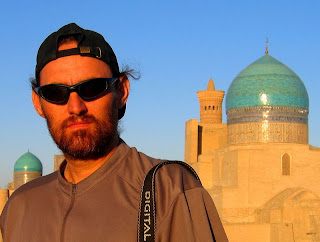
(Iglesia St. Roque, and procession)
San Roque the patron Saint of Tarija is celebrated for a week ending on the 16th of September. We were lucky enough to catch the last few days of the festival. Below you will see a few of the pictures we took during this time.

(Katheryna in the middle of things)
The festival (at least from our point of view) consists of daily parades of "Chunchos", preceding the Saint as he is paraded through the town. This is a very colorful and noisy procession, as the "Chunchos" are accompanied by drums and a couple of wind instruments. First a short single reed flute (not the andean multi-reed flute, but similar sounding), a short and very shrill sounding thing. In addition something which to me looked like the South American version of an Alp horn, though much lighter, as each musician carried his in the air while playing it. The instrument is called "La Caña", and is basically a long hollow tube, topped by a "horn", and doesn't have much of a sound, just a low hollow bass rumble, more or less. Unfortunately, the music, is very monotone, there is little variation, as there is only a basic rhythm with few notes, and after a few hours of this, you pretty much have had enough.

(The idol being paraded through town)
Some background on the San Roque festivities:
In 1875 "San Roque" "appeared" here in Tarija, Boliva (548 years after his death in Europe) and apparently his apparition healed a number of people of Leprosy. San Roque was himself miraculously cured of the plague in Italy. After having healed a number of people of the plague, he himself was afflicted, and kept alive by a dog while living in a cave, after having been expelled from the town. The owner of the dog noticed that the dog disappeared every day with a loaf of bread. After following the dog, he found San Roque in his cave. For the full story check this link. Wiki: Saint Roch


(The "Caña" instrument visible over the heads of the marchers)
Here in Tarija he is worshiped as the patron saint of the town, and every year there is a week long celebration. The daily celebration is higlighted by marching "Chunchos" in brightly colored garb preceding the statue of the saint as it is carried all around the town. The "Chunchos", 2500 strong this year, are made up people (exclusively male, but of all ages) who have made a "deal" with the saint. They are asking for relief for themselves or a family member from some sort of illness or other event which have befallen them. In return, they march in honor of the saint the 8 days the festivities last.

(Chunchos marching)
On the second to last day, there is a big party in front of the San Roque church, with all the "Chunchos" doing a dance and paying their respects to the Saint. As well as a fireworks, and a folkloric concert, there are some traditional events, such as the "Baile del Toro", in which someone dons a small headdress in the form of a bull, festooned with fireworks, and dances all around the plaza while the fireworks light up the bull. All in all this goes on into late into the night.


(Chunchos)
On the final night, the festivities are brought to an end by a final parade through the town ending with the Saint being brought back to the San Roque church, and all the "Chunchos" paying their final respects to the Saint for this year. The last day was also marked by a notable increase in the hangers-on and spectators. The plaza and the surrounding streets were jam packed hours before the saint made it back to the church.

(Chunchos)
On thing which I only noticed once I went through the pictures, is that the Saint is dressed differently on each day (at least the days that we saw him). Also, there were no tourists. This seemed to be an exclusively local festivities (at least this year). Though I think the political problems had a lot to do with the fact that there were no foreign tourists.

(Chunchos dancing in front of Iglesia San Roque)
Technorati Tags: Bolivia, San Roque, south america, Tarija, travel


No comments:
Post a Comment